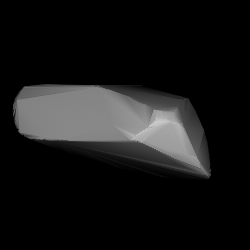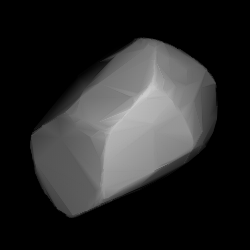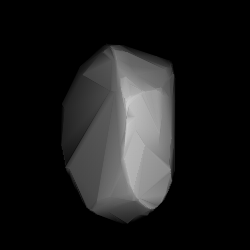Related Research Articles
1982 Cline, provisional designation 1975 VA, is a stony asteroid from the inner regions of the asteroid belt, approximately 8 kilometers in diameter. It was discovered on 4 November 1975, by American astronomer Eleanor Helin at Palomar Observatory in California, and named after Edwin Lee Cline, inventor and friend of the discoverer.
1179 Mally, provisional designation 1931 FD, is an asteroid and long-lost minor planet from the central region of the asteroid belt, approximately 13 kilometers in diameter. Discovered by Max Wolf in 1931, the asteroid was lost until its rediscovery in 1986. The discoverer named it after his daughter-in-law, Mally Wolf.

1050 Meta, provisional designation 1925 RC, is a stony Eunomia asteroid from the central regions of the asteroid belt, approximately 10 kilometers in diameter. It was discovered on 14 September 1925, by German astronomer Karl Reinmuth at the Heidelberg Observatory in southwest Germany. The meaning of the asteroids's name is unknown. The presumably S-type asteroid has a rotation period of 6.14 hours and possibly an elongated shape.
1142 Aetolia, provisional designation 1930 BC, is a stony background asteroid from the outer region of the asteroid belt, approximately 24 kilometers in diameter. It was discovered on 24 January 1930, by German astronomer Karl Reinmuth at the Heidelberg-Königstuhl State Observatory and named for the Greek region Aetolia.
2531 Cambridge, provisional designation 1980 LD, is a stony Eoan asteroid from the outer regions of the asteroid belt, approximately 20 kilometers in diameter. It was discovered on 11 June 1980, by American astronomer Edward Bowell at Lowell's Anderson Mesa Station in Arizona, United States. The asteroid was named for the Cambridge University.

1286 Banachiewicza is an elongated Eos asteroid from the outer regions of the asteroid belt. It was discovered on 25 August 1933, by Belgian astronomer Sylvain Arend at the Royal Observatory of Belgium in Uccle. The stony S-type asteroid has a rotation period of 8.6 hours and measures approximately 21 kilometers in diameter. It was named after Polish astronomer Tadeusz Banachiewicz.

1275 Cimbria is a Eunomia asteroid from the central regions of the asteroid belt, approximately 27 kilometers in diameter. It was discovered on 30 November 1932, by astronomer Karl Reinmuth at the Heidelberg-Königstuhl State Observatory in southern Germany. The asteroid was named after the Cimbri, an ancient Germanic tribe.

1274 Delportia, provisional designation 1932 WC, is a stony Florian asteroid from the inner regions of the asteroid belt, approximately 10 kilometers in diameter. It was discovered on 28 November 1932, by Belgian astronomer Eugène Delporte at Uccle Observatory in Belgium. It was named after the discoverer himself.
1806 Derice, provisional designation 1971 LC, is a stony Flora asteroid from the inner regions of the asteroid belt, approximately 10 kilometers in diameter. Discovered on 13 June 1971, at the Bickley site of the Perth Observatory in Western Australia, it was the first discovery of a minor planet ever made in Oceania. The asteroid was named after the wife of Dennis Harwood, staff member at Bickley.
3700 Geowilliams, provisional designation 1984 UL2, is a stony background asteroid from the inner regions of the asteroid belt, approximately 8 kilometers (5 miles) in diameter. It was discovered on 23 October 1984, by American astronomer couple Carolyn and Eugene Shoemaker at the Palomar Observatory in California, United States. The S k-subtype has a rotation period of 14.38 hours. It was named for Australian geologist George E. Williams.
2187 La Silla, provisionally designated 1976 UH, is a stony Eunomia asteroid from the middle region of the asteroid belt, approximately 12 kilometers in diameter.
3066 McFadden, provisional designation 1984 EO, is a stony background asteroid from the central regions of the asteroid belt, approximately 15 kilometers in diameter. It was discovered on 1 March 1984, by American astronomer Edward Bowell at the Anderson Mesa Station near Tucson, Arizona. It was named for American planetary scientist Lucy-Ann McFadden. The assumed S-type asteroid has a rotation period of 13.8 hours.

1837 Osita (prov. designation: 1971 QZ1) is a stony Flora asteroid from the inner regions of the asteroid belt, approximately 7 kilometers in diameter. It was discovered on 16 August 1971, by American astronomer James Gibson at the Yale–Columbia Southern Station of the Leoncito Astronomical Complex in Argentina, who named it after his wife Ursula ("Osita").
2122 Pyatiletka, provisional designation 1971 XB, is a stony asteroid from the inner regions of the asteroid belt, approximately 11 kilometers in diameter.
1737 Severny, provisional designation 1966 TJ, is a stony Eoan asteroid from the outer region of the asteroid belt, approximately 21 kilometers in diameter.
2554 Skiff, provisional designation 1980 OB, is a Florian asteroid from the inner regions of the asteroid belt, approximately 7 kilometers in diameter. It was discovered on 17 July 1980, by American astronomer Edward Bowell at Lowell's Anderson Mesa Station near Flagstaff, Arizona. The presumed S-type asteroid has a rotation period of 25.6 hours and was named after astronomer Brian Skiff.
2433 Sootiyo, provisional designation 1981 GJ, is a stony asteroid from the middle region of the asteroid belt, approximately 13 kilometers in diameter. It was discovered on 5 April 1981, by American astronomer Edward Bowell at Lowell's Anderson Mesa Station near Flagstaff, Arizona. The asteroid was named "Sootiya" meaning "star boy" in the Hopi language.

2111 Tselina is a stony Eos asteroid from the outer regions of the asteroid belt. It was discovered on 13 June 1969, by Soviet astronomer Tamara Smirnova at Crimean Astrophysical Observatory in Nauchnij, on the Crimean peninsula. The S-type asteroid has a rotation period of 6.6 hours and measures approximately 23 kilometers in diameter. It was later named after the Soviet Virgin Lands Campaign.
1259 Ógyalla, provisional designation 1933 BT, is a Themistian asteroid from the outer region of the asteroid belt, approximately 32 kilometers in diameter. It was discovered on 29 January 1933, by German astronomer Karl Reinmuth at Heidelberg Observatory in southwest Germany. The asteroid was named for the Hurbanovo Observatory.

5357 Sekiguchi is an Eos asteroid from the outer region of the asteroid belt, approximately 15 kilometers in diameter. It was discovered on 2 March 1992, by Japanese amateur astronomers Tetsuya Fujii and Kazuro Watanabe at the Kitami Observatory in eastern Hokkaidō, Japan. The asteroid was later named after Japanese astronomer Tomohiko Sekiguch.
References
- 1 2 3 4 "JPL Small-Body Database Browser: 4085 Weir (1985 JR)" (2017-11-28 last obs.). Jet Propulsion Laboratory. Retrieved 8 January 2018.
- 1 2 3 4 "4085 Weir (1985 JR)". Minor Planet Center. Retrieved 8 January 2018.
- 1 2 3 Schmadel, Lutz D. (2007). "(4085) Weir". Dictionary of Minor Planet Names. Springer Berlin Heidelberg. p. 349. doi:10.1007/978-3-540-29925-7_4063. ISBN 978-3-540-00238-3.
- 1 2 3 4 5 6 7 "LCDB Data for (4085) Weir". Asteroid Lightcurve Database (LCDB). Retrieved 8 January 2018.
- 1 2 "Asteroid 4085 Weir – Nesvorny HCM Asteroid Families V3.0". Small Bodies Data Ferret. Retrieved 27 October 2019.
- 1 2 3 Masiero, Joseph R.; Grav, T.; Mainzer, A. K.; Nugent, C. R.; Bauer, J. M.; Stevenson, R.; et al. (August 2014). "Main-belt Asteroids with WISE/NEOWISE: Near-infrared Albedos". The Astrophysical Journal. 791 (2): 11. arXiv: 1406.6645 . Bibcode:2014ApJ...791..121M. doi:10.1088/0004-637X/791/2/121.
- 1 2 3 4 Mainzer, A.; Grav, T.; Masiero, J.; Hand, E.; Bauer, J.; Tholen, D.; et al. (November 2011). "NEOWISE Studies of Spectrophotometrically Classified Asteroids: Preliminary Results". The Astrophysical Journal. 741 (2): 25. arXiv: 1109.6407 . Bibcode:2011ApJ...741...90M. doi:10.1088/0004-637X/741/2/90.
- 1 2 3 4 Usui, Fumihiko; Kuroda, Daisuke; Müller, Thomas G.; Hasegawa, Sunao; Ishiguro, Masateru; Ootsubo, Takafumi; et al. (October 2011). "Asteroid Catalog Using Akari: AKARI/IRC Mid-Infrared Asteroid Survey". Publications of the Astronomical Society of Japan. 63 (5): 1117–1138. Bibcode:2011PASJ...63.1117U. doi:10.1093/pasj/63.5.1117.
- 1 2 Warner, Brian D. (December 2006). "Asteroid lightcurve analysis at the Palmer Divide Observatory - March - June 2006". The Minor Planet Bulletin. 33 (4): 85–88. Bibcode:2006MPBu...33...85W. ISSN 1052-8091 . Retrieved 8 January 2018.
- 1 2 3 Waszczak, Adam; Chang, Chan-Kao; Ofek, Eran O.; Laher, Russ; Masci, Frank; Levitan, David; et al. (September 2015). "Asteroid Light Curves from the Palomar Transient Factory Survey: Rotation Periods and Phase Functions from Sparse Photometry". The Astronomical Journal. 150 (3): 35. arXiv: 1504.04041 . Bibcode:2015AJ....150...75W. doi:10.1088/0004-6256/150/3/75 . Retrieved 8 January 2018.
- ↑ Veres, Peter; Jedicke, Robert; Fitzsimmons, Alan; Denneau, Larry; Granvik, Mikael; Bolin, Bryce; et al. (November 2015). "Absolute magnitudes and slope parameters for 250,000 asteroids observed by Pan-STARRS PS1 - Preliminary results". Icarus. 261: 34–47. arXiv: 1506.00762 . Bibcode:2015Icar..261...34V. doi:10.1016/j.icarus.2015.08.007 . Retrieved 8 January 2018.
- 1 2 Nesvorný, D.; Broz, M.; Carruba, V. (December 2014). "Identification and Dynamical Properties of Asteroid Families". Asteroids IV. pp. 297–321. arXiv: 1502.01628 . Bibcode:2015aste.book..297N. doi:10.2458/azu_uapress_9780816532131-ch016. ISBN 9780816532131.
- ↑ "MPC/MPO/MPS Archive". Minor Planet Center. Retrieved 8 January 2018.